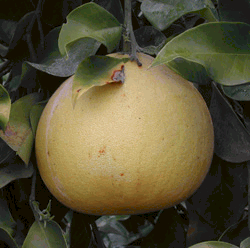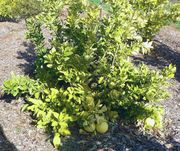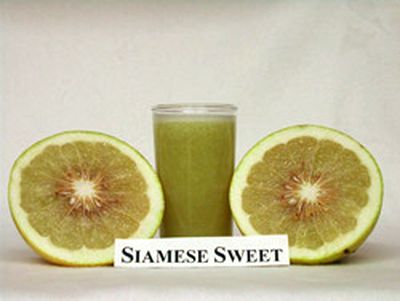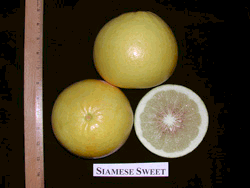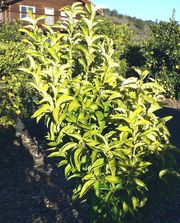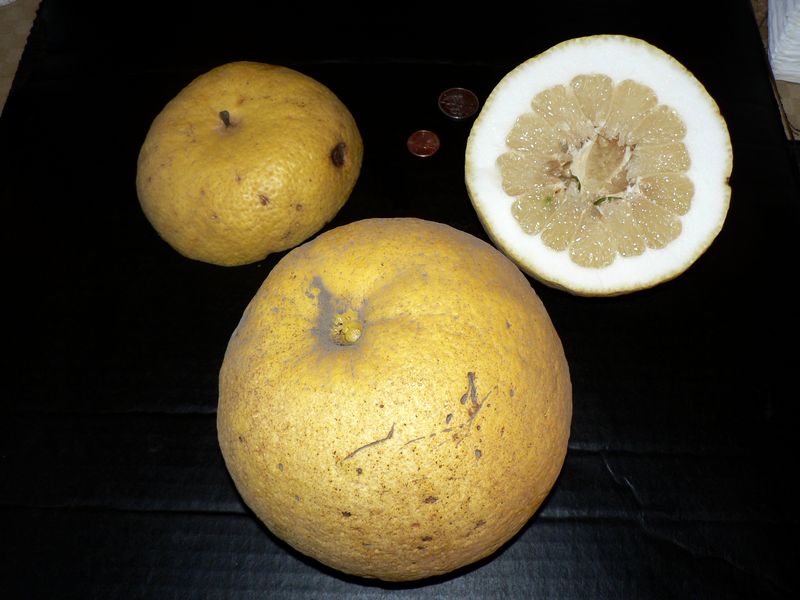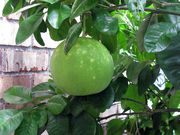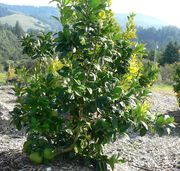|
|||||||||
Select any of 50 available languages! |
|||||||||
Pomelo (Pummelo) |
||
| Citrus maxima |
 |
Origin Cultivation Colour History Pomelo |
| 'Mato
Buntan' pomelo © Gene Lester |
Origin
Cultivation
History
|
| LAT | Citrus maxima ’Sweetie’ | 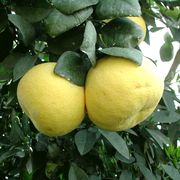  |
| Syn | Citrus maxima 'Siamese
Sweet' x
Citrus paradisi '4n Marsh' Citrus paradisi ’Oroblanco’ Citrus paradisi 'Jaffa Sweetie' |
|
Sweetie is one of the newest pomelo hybrids. Its parents are Siamese Sweet pomelo (described above) and a variant of Marsh grapefruit developed at the University of California, Riverside. The cross was made in 1958 and the new variety released in 1980. The flesh is pale yellow and the taste mild and sweet. This is one of the pomelos that retain some green on its rind even when ripe. The variety is also sold as Oroblanco grapefruit. A similar cross made in Israel was released for sale in 1984 under the name 'Sweetie'. The Israeli 'Jaffa Sweetie' is sold as a variety of grapefruit and can remain dark green even when fully ripe, but tastes sweet nonetheless. |
||
| ENG | Sweetie, Jaffa Sweetie, Oroblanco grapefruit | |
| FRA | Pomelo Sweetie, Pomelo Oroblanco | |
| Photo | © CCPP ©Citrus Marketing Board of Israel |
|
| LAT | Citrus maxima ‘Cocktail’ |   |
| Syn | Citrus maxima 'Siamese Sweet' x Citrus reticulata 'Frua' |
|
|
Cocktail is a cross of the Siamese Sweet pomelo and the Frua mandarin made in 1966, developed in Riverside, California. Thinner peeled than most pomelos, the fruit has seeds and is very juicy. The peel, flesh and juice are mandarin-coloured. The flavour is pleasant and sub-acid. Cocktail matures in early winter and the fruits hold well on the tree. Cocktail trees are large and vigorous. The fruit can vary from the size of an orange to the size of a grapefruit. This hybrid is discussed on the Grapefruit page as > Cocktail grapefruit. |
||
| ENG | Cocktail
pomelo |
|
| FRA | Pamplemousse Cocktail | |
| Photo | © UCR Citrus
Variety Collection © CCPP |
|
| |
||
|
|
||
| LAT | Citrus maxima 'Ugli' |    |
| Syn | Citrus x ugli Citrus maxima x C. reticulata x C. aurantium |
|
|
Originally uglis were
thought to be chance hybrids of mandarin and grapefruit. Closer
examination of
the various strands has shown that many parents are involved. Because
of the
monoembryony exhibited by the seeds, some botanists are of the opinion
that a pomelo
is the parent in question rather than grapefruit. |
||
| ENG | Ugli
fruit |
|
| FRA | Tangelo ugli | |
| Photo | (1) © C. Jacquemond / INRA (2-3) © Gene Lester |
|
| Link | ||





